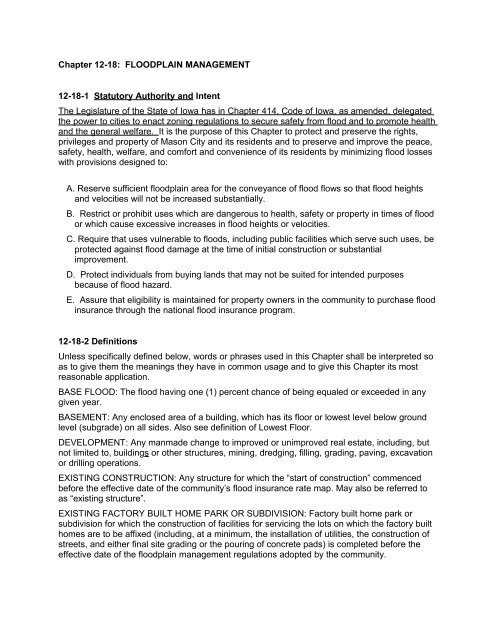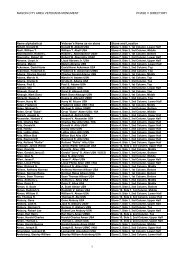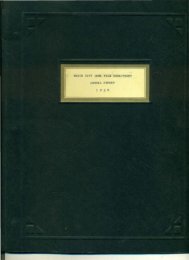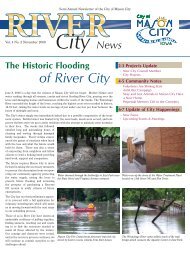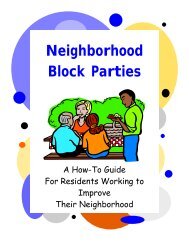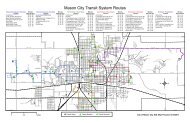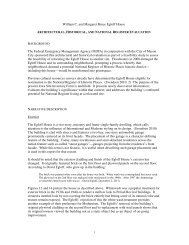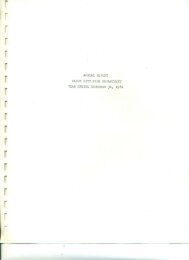Chapter 12-18: FLOODPLAIN MANAGEMENT - Mason City, Iowa
Chapter 12-18: FLOODPLAIN MANAGEMENT - Mason City, Iowa
Chapter 12-18: FLOODPLAIN MANAGEMENT - Mason City, Iowa
You also want an ePaper? Increase the reach of your titles
YUMPU automatically turns print PDFs into web optimized ePapers that Google loves.
<strong>Chapter</strong> <strong>12</strong>-<strong>18</strong>: <strong>FLOODPLAIN</strong> <strong>MANAGEMENT</strong><strong>12</strong>-<strong>18</strong>-1 Statutory Authority and IntentThe Legislature of the State of <strong>Iowa</strong> has in <strong>Chapter</strong> 414, Code of <strong>Iowa</strong>, as amended, delegatedthe power to cities to enact zoning regulations to secure safety from flood and to promote healthand the general welfare. It is the purpose of this <strong>Chapter</strong> to protect and preserve the rights,privileges and property of <strong>Mason</strong> <strong>City</strong> and its residents and to preserve and improve the peace,safety, health, welfare, and comfort and convenience of its residents by minimizing flood losseswith provisions designed to:A. Reserve sufficient floodplain area for the conveyance of flood flows so that flood heightsand velocities will not be increased substantially.B. Restrict or prohibit uses which are dangerous to health, safety or property in times of floodor which cause excessive increases in flood heights or velocities.C. Require that uses vulnerable to floods, including public facilities which serve such uses, beprotected against flood damage at the time of initial construction or substantialimprovement.D. Protect individuals from buying lands that may not be suited for intended purposesbecause of flood hazard.E. Assure that eligibility is maintained for property owners in the community to purchase floodinsurance through the national flood insurance program.<strong>12</strong>-<strong>18</strong>-2 DefinitionsUnless specifically defined below, words or phrases used in this <strong>Chapter</strong> shall be interpreted soas to give them the meanings they have in common usage and to give this <strong>Chapter</strong> its mostreasonable application.BASE FLOOD: The flood having one (1) percent chance of being equaled or exceeded in anygiven year.BASEMENT: Any enclosed area of a building, which has its floor or lowest level below groundlevel (subgrade) on all sides. Also see definition of Lowest Floor.DEVELOPMENT: Any manmade change to improved or unimproved real estate, including, butnot limited to, buildings or other structures, mining, dredging, filling, grading, paving, excavationor drilling operations.EXISTING CONSTRUCTION: Any structure for which the “start of construction” commencedbefore the effective date of the community’s flood insurance rate map. May also be referred toas “existing structure”.EXISTING FACTORY BUILT HOME PARK OR SUBDIVISION: Factory built home park orsubdivision for which the construction of facilities for servicing the lots on which the factory builthomes are to be affixed (including, at a minimum, the installation of utilities, the construction ofstreets, and either final site grading or the pouring of concrete pads) is completed before theeffective date of the floodplain management regulations adopted by the community.
EXPANSION OF EXISTING FACTORY BUILT HOME PARK OR SUBDIVISION: Thepreparation of additional sites by the construction of facilities for servicing the lots on which thefactory built homes are to be affixed (including, at a minimum, the installation of utilities, theconstruction of streets, and either final site grading or the pouring of concrete pads).FACTORY BUILT HOME: Any structure, designed for residential use, which is wholly or insubstantial part made, fabricated, formed or assembled in manufacturing facilities for installationor assembly and installation on a building site. For the purpose of this <strong>Chapter</strong> factory builthomes include mobile homes, manufactured homes and modular homes and also include“recreational vehicles” which are placed on a site for greater than one hundred eighty (<strong>18</strong>0)consecutive days and not fully licensed for and ready for highway use.FACTORY BUILT HOME PARK: A parcel or contiguous parcels of land divided into two (2) ormore factory built home lots for sale or lease.FLOOD: General and temporary condition of partial or complete inundation of normally dry landareas resulting from the overflow of streams or rivers or from the unusual and rapid runoff ofsurface waters from any source.FLOOD ELEVATION: The elevation floodwaters would reach at a particular site during theoccurrence of a specific flood. For instance, the base flood elevation is the elevation offloodwaters related to the occurrence of the one (1) percent flood.FLOOD INSURANCE RATE MAP (FIRM): The official map prepared as part of (but publishedseparately from) the flood insurance study which delineates both the flood hazard areas and therisk premium zones applicable to the community.<strong>FLOODPLAIN</strong>: Any land area susceptible to being inundated by water as a result of a flood.<strong>FLOODPLAIN</strong> <strong>MANAGEMENT</strong>: An overall program of corrective and preventive measures forreducing flood damages and promoting the wise use of floodplains, including, but not limited to,emergency preparedness plans, flood control works, floodproofing and floodplain managementregulations.FLOODPROOFING: Any combination of structural and nonstructural additions, changes, oradjustments to structures, including utility and sanitary facilities, which will reduce or eliminateflood damage to such structures.FLOODWAY: The channel of a river or stream and those portions of the floodplains adjoiningthe channel, which are reasonably required to carry and discharge floodwaters or flood flows sothat confinement of flood flows to the floodway area will not cumulatively increase the watersurface elevation of the base flood by more than one (1) foot.FLOODWAY FRINGE: Those portions of the floodplain, other than the floodway, which can befilled, leveed, or otherwise obstructed without causing substantially higher flood levels or flowvelocities.HISTORIC STRUCTURE: Any structure that is:A. Listed individually in the National Register of Historic Places, maintained by the Departmentof Interior, or preliminarily determined by the Secretary of the Interior as meeting therequirements for individual listing of the National Register;B. Certified or preliminarily determined by the Secretary of the Interior as contributing to thehistorical significance of a registered historic district or a district preliminarily determined bythe Secretary to qualify as a registered historic district;
C. Individually listed on a state inventory of historic places in states with historic preservationprograms which have been approved by the Secretary of the Interior; orD. Individually listed on a local inventory of historic places in communities with historicpreservation programs that have been certified by either: 1) an approved state program asdetermined by the Secretary of the Interior or 2) directly by the Secretary of the Interior instates without approved programs.LOWEST FLOOR: The floor of the lowest enclosed area in a building including a basementexcept when all the following criteria are met:A. The enclosed area is designed to flood to equalize hydrostatic pressure during floods withwalls or openings that satisfy the provisions of <strong>Chapter</strong> <strong>12</strong>-<strong>18</strong>-13B-5a, andB. The enclosed area is unfinished (not carpeted, drywalled, etc.) and used solely for lowdamage potential uses such as building access, parking or storage, andC. Machinery and service facilities (e.g., hot water heater, furnace, electrical service) containedin the enclosed area are located at least three (3) feet above the base flood level, andD. The enclosed area is not a “basement” as defined in these definitions. In cases where thelowest enclosed area satisfies criteria in Subsections A, B, C, and D of this definition, thelowest floor is the floor of the next highest enclosed area that does not satisfy the criteriaabove.MINOR PROJECTS: Small development activities (except for filling, grading and excavating)valued at less than $500.NEW CONSTRUCTION (New Buildings, Factory Built Home Parks): Those structures ordevelopment for which the start of construction commenced on or after May 16, 20<strong>12</strong> March 16,1995, the effective date of the flood insurance rate map.NEW FACTORY BUILT HOME PARK OR SUBDIVISION: A factory built home park orsubdivision for which the construction of facilities for servicing the lots on which the factory builthomes are to be affixed (including, at a minimum, the installation of utilities, the construction ofstreets, and either final site grading or the pouring of concrete pads) is completed on or after theeffective date of the floodplain management regulations adopted by the community.RECREATIONAL VEHICLE: A vehicle which is:A. Built on a single chassis;B. Four hundred (400) square feet or less when measured at the largest horizontal projection;C. Designed to be self-propelled or permanently towable by a light duty truck;D. Designed primarily not for use as a permanent dwelling but as a temporary living quartersfor recreational, camping, travel, or seasonal use.REPETITIVE LOSS: Flood-related damages sustained by a structure on two separateoccasions during a 10-year period for which the cost of repairs at the time of each such floodevent, equals or exceeds twenty-five percent of the market value of the structure before thedamage occurred.ROUTINE MAINTENANCE OF EXISTING BUILDINGS AND FACILITIES: Repairs necessaryto keep a structure in a safe and habitable condition that do not trigger a building permit,provided they are not associated with a general improvement of the structure or repair of adamaged structure. Such repairs include:
A. Normal maintenance of structures such as re-roofing, replacing roofing tiles andreplacing siding;B. Exterior and interior painting, papering, tiling, carpeting, cabinets, counter tops andsimilar finish work;C. Basement sealing;D. Repairing or replacing damaged or broken window panes;E. Repairing plumbing systems, electrical systems, heating or air conditioning systems andrepairing wells or septic systems.SPECIAL FLOOD HAZARD AREA: The land within a community subject to the “base flood”.This land is identified as zone A and shaded zone X on the community’s flood insurance ratemap.START OF CONSTRUCTION: Includes substantial improvement, and means the date thedevelopment permit was issued, provided the actual start of construction, repair, reconstruction,rehabilitation, addition, placement, or other improvement, was within one hundred eighty (<strong>18</strong>0)days of the permit date. The “actual start” means either the first placement or permanentconstruction of a structure on a site, such as pouring of a slab or footings, the installation of pile,the construction of columns, or any work beyond the stage of excavation; or the placement of afactory built home on a foundation. Permanent construction does not include land preparation,such as clearing, grading and filling; nor does it include the installation of streets and/orwalkways; nor does it include excavation for a basement, footings, piers, or foundations or theerection of temporary forms; nor does it include the installation on the property of accessorybuildings such as garages or sheds not occupied as dwelling units or not part of the mainstructure. For a substantial improvement, the “actual start of construction” means the firstalteration of any wall, ceiling, floor, or other structural part of the building, whether or not thatalteration affects the external dimensions of the building.STRUCTURE: Anything constructed or erected on the ground or attached to the ground,including, but not limited to, buildings, factories, sheds, cabins, factory built homes, storagetanks, and other similar uses.SUBSTANTIAL DAMAGE: Any Ddamage to a structure which satisfies any of the followingcriteria:A. Damage of any origin sustained by a structure whereby the cost of restoring thestructure to its before damage condition would equal or exceed fifty (50) percent of themarket value of the structure before the damage occurred.B. , or dDamage of any origin sustained by a structure designated as a “repetitive lossstructure” by the federal emergency management agency or the national flood insuranceprogram whereby the cost of restoring the structure to its before damage condition wouldequal or exceed twenty-five (25) percent of the market value of the structure before thedamage occurred.C. Flood-related damages sustained by a structure on two separate occasions during a 10-year period for which the cost of repairs at the time of such flood event, on the average,equals or exceeds 25 percent of the market value of the structure before the damageoccurred
SUBSTANTIAL IMPROVEMENT: Any improvement to a structure which satisfies either of thefollowing criteria:A. Any repair, reconstruction, or improvement of a structure, the cost of which equals orexceeds fifty (50) percent of the market value of the structure either: 1) before the “startof construction” of the improvement, or 2) if the structure has been “substantiallydamaged” and is being restored, before the damage occurred. The term includesstructures which have incurred “repetitive loss” or “substantial damage,” regardless ofthe actual repair work performed. This term does not, however, include any project forimprovement of a structure to comply with existing state or local health, sanitary, orsafety code specifications which are solely necessary to assure safe conditions for theexisting use. This term also does not include any alteration of a “historic structure”,provided the alteration will not preclude the structure’s designation as a “historicstructure”.B. Any addition which increases the original floor area of a building by twenty-five (25)percent or more. The floor area of all additions constructed after March 16, 1995 May16, 20<strong>12</strong>, shall be added to any proposed addition in determining whether the totalincrease in original floor space would exceed twenty-five (25) percent.VARIANCE: grant of relief by a community from the terms of the floodplain managementregulations.VIOLATION: The failure of a structure or other development to be fully compliant with thecommunity’s floodplain management regulations.<strong>12</strong>-<strong>18</strong>-3 Lands to Which This <strong>Chapter</strong> AppliesThe provisions of this <strong>Chapter</strong> shall apply to all lands within the jurisdiction of <strong>Mason</strong> <strong>City</strong> shownon the official floodplain zoning map as being within the boundaries of the floodway, floodwayfringe, general floodplain and shallow flooding (overlay) districts, as established in <strong>Chapter</strong> <strong>12</strong>-<strong>18</strong>-4.<strong>12</strong>-<strong>18</strong>-4 Establishment of Official Floodplain Zoning MapThe flood insurance rate maps (FIRM) prepared as part of the flood insurance study for CerroGordo County and Incorporated Areas, <strong>City</strong> of <strong>Mason</strong> <strong>City</strong>, Panels 19033C0142C, 0144C,0161C, 0162C, 0163C, 0164C, 0167C, 0168C, 0169C, 0<strong>18</strong>8C, 0251C, 0252C, dated May 16,20<strong>12</strong> <strong>Mason</strong> <strong>City</strong>, dated March 16, 1995, and those panels of the flood insurance rate map forCerro Gordo County, dated December 1, 2001, that include those portions of Cerro GordoCounty annexed by <strong>Mason</strong> <strong>City</strong> after March 16, 1995, are hereby adopted by reference anddeclared to be the official floodplain zoning map. The flood profiles and all explanatory materialcontained with the flood insurance study are also declared to be a part of this <strong>Chapter</strong>.<strong>12</strong>-<strong>18</strong>-5 Rules for Interpretation of District BoundariesThe boundaries of the zoning district areas shall be determined by scaling distances on theofficial floodplain zoning map. When an interpretation is needed as to the exact location of aboundary, the Administrative Officer shall make the necessary interpretation. The Zoning Boardof Adjustment, hereinafter referred to as the Board, shall hear and decide appeals when it is
alleged that there is an error in any requirement, decision, or determination made by theAdministrative Officer in the enforcement or administration of this <strong>Chapter</strong>.<strong>12</strong>-<strong>18</strong>-6 ComplianceNo structure or land shall hereafter be used and no structure shall be located, extended,converted or structurally altered without full compliance with the terms of this <strong>Chapter</strong> and otherapplicable regulations which apply to uses within the jurisdiction of this <strong>Chapter</strong>.<strong>12</strong>-<strong>18</strong>-7 Abrogation and Greater RestrictionsIt is not intended by this <strong>Chapter</strong> to repeal, abrogate or impair any existing easements,covenants, or deed restrictions. However, where this <strong>Chapter</strong> imposes greater restrictions, theprovisions of this <strong>Chapter</strong> shall prevail. All other chapters inconsistent with this <strong>Chapter</strong> arehereby repealed to the extent of the inconsistency only.<strong>12</strong>-<strong>18</strong>-8 InterpretationIn their interpretation and application, the provisions of this <strong>Chapter</strong> shall be held to be minimumrequirements and shall be liberally construed in favor of the governing body and shall not bedeemed a limitation or repeal of any other powers granted by state statutes.<strong>12</strong>-<strong>18</strong>-9 Warning and Disclaimer of LiabilityThe standards required by this <strong>Chapter</strong> are considered reasonable for regulatory purposes. This<strong>Chapter</strong> does not imply that areas outside the designated floodplain overlay district areas will befree from flooding or flood damages. This <strong>Chapter</strong> shall not create liability on the part of <strong>Mason</strong><strong>City</strong> or any officer or employee thereof for any flood damages that arise from reliance on this<strong>Chapter</strong> or any administrative decision lawfully made there under.<strong>12</strong>-<strong>18</strong>-10 SeverabilityIf any section, clause, provision or portion of this <strong>Chapter</strong> is adjudged unconstitutional or invalidby a court of competent jurisdiction, the remainder of this <strong>Chapter</strong> shall not be affected thereby.<strong>12</strong>-<strong>18</strong>-11 Establishment of Zoning (Overlay) DistrictsThe floodplain areas within the jurisdiction of this <strong>Chapter</strong> are hereby divided into the followingdistricts:A. FLOODWAY OVERLAY DISTRICT(FW): The floodway overlay district shall include thefloodway shown on the floodplain zoning map adopted in <strong>Chapter</strong> <strong>12</strong>-<strong>18</strong>-4.B. FLOODWAY FRINGE OVERLAY DISTRICT(FF): The floodway fringe overlay district shallinclude the following areas depicted on the floodplain zoning map adopted in <strong>Chapter</strong> <strong>12</strong>-<strong>18</strong>-4:1. Tthose areas outside the floodway overlay district designated as zone AE, and
d. All fill added to the lot since May 1, 2006 shall be added to the proposed fill indetermining whether more than twenty (20) percent of the lot has been filled.2. STRUCTURES: All structures shall:a. Be adequately anchored to prevent flotation, collapse or lateral movement of thestructure.b. Use construction methods and practices that will minimize flood damage.c. Use construction materials and utility equipment that are resistant to flood damage.3. RESIDENTIAL BUILDINGS: All new or substantially improved residential structures shallhave the lowest floor (including basement) elevated a minimum of three (3) feet above thebase flood level. Construction shall be upon compacted fill which shall, at all points, be nolower than three (3) feet above the base flood level and extend at such elevation at leasteighteen (<strong>18</strong>) feet beyond the limits of any structure erected thereon. Alternate methodsof elevating (such as piers) may be allowed subject to approval by the Board, whereexisting topography, street grades, or other factors preclude elevating by fill. In suchcases, the methods used must be adequate to support the structure as well as withstandthe various forces and hazards associated with flooding. All new residential structuresshall be provided with a means of access which will be passable by wheeled vehiclesduring the base flood.4. NONRESIDENTIAL BUILDINGS: All new or substantially improved nonresidential buildingsshall have the lowest floor (including basement) elevated a minimum of three (3) feetabove the base flood level, or together with attendant utility and sanitary systems, befloodproofed to such a level. When floodproofing is utilized, a professional engineerregistered in the state of <strong>Iowa</strong> shall certify that the floodproofing methods used areadequate to withstand the flood depths, pressures, velocities, impact and uplift forces andother factors associated with the base flood; and that the structure, below the base floodlevel, is watertight with walls substantially impermeable to the passage of water. A recordof the certification indicating the specific elevation (in relation to national geodetic NorthAmerican vertical datum) to which any structures are floodproofed shall be maintained bythe administrator.5. ALL NEW AND SUBSTANTIALLY IMPROVED STRUCTURES:a. Fully enclosed areas below the “lowest floor” (not including basements) that are subjectto flooding shall be designed to automatically equalize hydrostatic flood forces onexterior walls by allowing for the entry and exit of floodwaters. Designs for meetingthis requirement must either be certified by a registered professional engineer or meetor exceed the following minimum criteria:(1.) A minimum of two (2) openings having a total net area of not less than one squareinch for every square foot of enclosed area subject to flooding shall be provided.(2.) The bottom of all openings shall be no higher than one (1) foot above grade.(3.) Openings may be equipped with screens, louvers, valves, or other coverings ordevices provided they permit the automatic entry and exit of floodwaters.(4.) Such areas shall be used solely for parking of vehicles, building access and lowdamage potential storage.b. New and substantially improved structures must be designed (or modified) andadequately anchored to prevent flotation, collapse, or lateral movement of the
structure resulting from hydrodynamic and hydrostatic loads, including the effects ofbuoyancy.c. New and substantially improved structures must be constructed with electrical, heating,ventilation, plumbing, and air conditioning equipment and other service facilities thatare designed and/or located so as to prevent water from entering or accumulatingwithin the components during conditions of flooding.6. FACTORY BUILT HOMES:a. All factory built homes, including those placed in existing factory built home parks orsubdivisions, shall be elevated on a permanent foundation such that the lowest floorof the structure is a minimum of three (3) feet above the base flood level.b. All factory built homes, including those placed in existing factory built home parks orsubdivisions, shall be anchored to resist flotation, collapse, or lateral movement.Methods of anchoring may include, but are not limited to, use of over the top or frameties to ground anchors.7. UTILITY AND SANITARY SYSTEMS:a. On-site waste disposal and water supply systems shall be located or designed to avoidimpairment to the system or contamination from the system during flooding.b. All new and replacement sanitary sewage systems shall be designed to minimize oreliminate infiltration of floodwaters into the system as well as the discharge of effluentinto floodwaters. Wastewater treatment facilities (other than on-site systems) shall beprovided with a level of flood protection equal to or greater than three (3)feet abovethe base flood level elevation.c. New or replacement water supply systems shall be designed to minimize or eliminateinfiltration of floodwaters into the system. Water supply treatment facilities (other thanon-site systems) shall be provided with a level of protection equal to or greater thanthree (3) feet above the base flood level elevation.d. Utilities such as gas or electrical systems shall be located and constructed to minimizeor eliminate flood damage to the system and the risk associated with such flooddamaged or impaired systems.8. STORAGE OF MATERIALS AND EQUIPMENT: Storage of materials and equipment thatare flammable, explosive or injurious to human, animal or plant life is prohibited unlesselevated a minimum of three (3) feet above the base flood level elevation. Other materialand equipment must either be similarly elevated or: a) not be subject to major flooddamage and be anchored to prevent movement due to floodwaters, or b) be readilyremovable from the area within the time available after flood warning.9. FLOOD CONTROL STRUCTURAL WORKS: Flood control structural works such aslevees, floodwalls, etc., shall provide, at a minimum, protection from a base flood with aminimum of six (6) feet of design freeboard and shall provide for adequate interiordrainage. In addition, structural flood control works shall be approved by the <strong>Iowa</strong>department of natural resources.10. WATERCOURSE ALTERATIONS OR RELOCATIONS: Watercourse alterations orrelocations must be designed to maintain the flood carrying capacity within the altered orrelocated portion. In addition, such alterations or relocations must be approved by the<strong>Iowa</strong> department of natural resources.
11. SUBDIVISIONS: Subdivisions (including factory built home parks and subdivisions) shallbe consistent with the need to minimize flood damages and shall have adequate drainageprovided to reduce exposure to flood damage. Development associated with subdivisionproposals (including the installation of public utilities) shall meet the applicableperformance standards of this <strong>Chapter</strong>. Subdivision proposals intended for residential useshall provide all lots with a means of access that will be passable by wheeled vehiclesduring the base flood. Preliminary and final plats for all new subdivisions shall includebase flood elevation data for those areas located within the floodplain overlay district.<strong>12</strong>. ACCESSORY STRUCTURES:a. Detached garages, sheds, and similar structures accessory to a residential use areexempt from the base flood elevation requirements where the following criteria aresatisfied:(1.) The structure shall not be used for human habitation.(2.) The structure shall be designed to have low flood damage potential.(3.) The structure shall be constructed and placed on the building site so as to offerminimum resistance to the flow of floodwaters.(4.) The structure shall be firmly anchored to prevent flotation which may result indamage to other structures.(5.) The structure’s service facilities such as electrical and heating equipment shall beelevated or floodproofed to at least three (3) feet above the base flood elevation.b. Exemption from the base flood elevation requirements for such a structure may resultin increased premium rates for flood insurance coverage of the structure and itscontents.13. RECREATIONAL VEHICLES:a. Recreational vehicles are exempt from the requirements of <strong>Chapter</strong> <strong>12</strong>-<strong>18</strong>-13B-6regarding anchoring and elevation of factory built homes when the following criteriaare satisfied:(1.) The recreational vehicle shall be located on the site for less than one hundredeighty (<strong>18</strong>0) consecutive days, and(2.) The recreational vehicle must be fully licensed and ready for highway use. Arecreational vehicle is ready for highway use if it is on its wheels or jacking systemand is attached to the site only by quick disconnect type utilities and securitydevices and has no permanently attached additions.b. Recreational vehicles that are located on the site for more than one hundred eighty(<strong>18</strong>0) consecutive days or are not ready for highway use must satisfy requirements of<strong>Chapter</strong> <strong>12</strong>-<strong>18</strong>-13B-6 regarding anchoring and elevation of factory built homes.14. PIPELINE RIVER AND STREAM CROSSINGS: Pipeline river and stream crossings shallbe buried in the streambed and banks, or otherwise sufficiently protected to preventrupture due to channel degradation, meandering, and the action of flood flows.<strong>12</strong>-<strong>18</strong>-14 General Floodplain Overlay DistrictA. PERMITTED USES: The following uses shall be permitted within the general floodplaindistrict to the extent they are not prohibited by any other code (or underlying zoning district)
and provided they do not include placement of structures, factory built homes, fill or otherobstructions, the storage of materials or equipment, excavation or alteration of a watercourse:1. Agricultural uses such as general farming, pasture, grazing, outdoor plant nurseries,horticulture, viticulture, truck farming, forestry, sod farming and wild crop harvesting.2. Industrial-commercial uses such as loading areas, parking areas, airport landing strips.3. Private and public recreational uses such as golf courses, tennis courts, driving ranges,archery ranges, picnic grounds, boat launching ramps, swimming areas, parks, wildlifeand nature preserves, game farms, fish hatcheries, shooting preserves, target ranges,trap and skeet ranges, hunting and fishing areas, hiking and horseback riding trails.4. Residential uses such as lawns, gardens, parking areas and play areas.B. CONDITIONAL USES: Any uses which involve placement of structures, factory built homes,fill or other obstructions, storage of materials or equipment, excavation or alteration of awatercourse may be allowed only upon issuance of a conditional use permit by the Board asprovided for in <strong>Chapter</strong> <strong>12</strong>-<strong>18</strong>-16 of this Ordinance. All such uses shall be reviewed by thedepartment of natural resources to determine: 1) whether the land involved is either whollyor partly within the floodway or floodway fringe and 2) the base flood level. The applicantshall be responsible for providing the department of natural resources with sufficienttechnical information to make the determination.C. PERFORMANCESTANDARDS:1. All conditional uses, or portions thereof, to be located in the floodway as determined by thedepartment of natural resources shall meet the applicable provisions and standards of thefloodway overlay district in <strong>Chapter</strong> <strong>12</strong>-<strong>18</strong>-<strong>12</strong>.2. All conditional uses, or portions thereof, to be located in the floodway fringe as determinedby the department of natural resources shall meet the applicable provisions andstandards of the floodway fringe overlay district in <strong>Chapter</strong> <strong>12</strong>-<strong>18</strong>-13.<strong>12</strong>-<strong>18</strong>-15 Shallow Flooding Overlay District (SF)A. PERMITTED USES: All uses within the shallow flooding district shall be permitted to theextent that they are not prohibited by any other code (or underlying zoning district) andprovided they meet the applicable performance standards of the shallow flooding district.B. PERFORMANCE STANDARDS: The performance standards for the shallow flooding districtshall be the same as the performance standards for the floodway fringe district with thefollowing exceptions:1. In shallow flooding areas designated as an AO zone on the flood insurance rate map, theminimum floodproofing/flood protection elevation shall be equal to the number of feet asspecified on the FIRM (or a minimum of 4 feet if no number is specified) above thehighest natural grade adjacent to the structure.2. In shallow flooding areas designated as an AH zone on the flood insurance rate map, theminimum floodproofing/flood protection elevation shall be equal to the elevation asspecified on the FIRM.3. In Zones AO and AH, required drainage paths shall be constructed around structures onslopes to guide water away from structures.<strong>12</strong>-<strong>18</strong>-16 Administration
A. APPOINTMENT, DUTIES AND RESPONSIBILITIES OF ADMINISTRATIVEOFFICER: TheAdministrative Officer is hereby appointed to implement and administer the provisions of this<strong>Chapter</strong> and will herein be referred to as the administrator. Duties and responsibilities of theadministrator shall include, but not necessarily be limited to, the following:1. Review all floodplain development permit applications to assure that the provisions of this<strong>Chapter</strong> will be satisfied.2. Review floodplain development applications to assure that all necessary permits havebeen obtained from federal, state and local governmental agencies including approvalwhen required from the department of natural resources for floodplain construction.
3. RECORD AND MAINTAIN A RECORD OF:a. The elevation (in relation to national geodetic North American vertical datum) of thelowest floor (including basement) of all new or substantially improved structures, orb. The elevation to which new or substantially improved structures have beenfloodproofed.4. Notify adjacent communities/counties and the department of natural resources prior toany proposed alteration or relocation of a watercourse and submit evidence of suchnotifications to the federal emergency management agency.5. Keep a record of all permits, appeals and such other transactions and correspondencepertaining to the administration of this <strong>Chapter</strong>.6. Submit to the federal insurance administrator an annual report concerning thecommunity’s participation, utilizing the annual report form supplied by the federalinsurance administrator.7. Notify the federal emergency management agency of any annexations or modifications tothe community’s boundaries.8. Review subdivision proposals to ensure such proposals are consistent with the purposeof this <strong>Chapter</strong> and advise the Council of potential conflict.B. <strong>FLOODPLAIN</strong> DEVELOPMENT PERMIT:1. PERMIT REQUIRED: A floodplain development permit issued by the administrator shallbe secured prior to any floodplain development (any manmade change to improved orunimproved real estate, including, but not limited to, buildings or other structures, mining,filling, grading, paving, excavation or drilling operations), including the placement offactory built homes.2. APPLICATION FORPERMIT: Application shall be made on forms furnished by theadministrator and shall include the following:a. Description of the work to be covered by the permit for which application is to bemade.b. Description of the land on which the proposed work is to be done (i.e., lot, block, tract,street address or similar description) that will readily identify and locate the work tobe done.c. Indication of the use or occupancy for which the proposed work is intended.d. Elevation of the base flood.e. Elevation (in relation to national geodetic North American vertical datum) of the lowestfloor (including basement) of buildings or of the level to which a building is to befloodproofed.f. For buildings being improved or rebuilt, the estimated cost of improvements andmarket value of the building prior to the improvements.g. Such other information as the administrator deems reasonably necessary (e.g.,drawings or a site plan) for the purpose of this <strong>Chapter</strong>.3. ACTION ON PERMIT APPLICATION: The administrator shall, within a reasonable time,make a determination as to whether the proposed floodplain development meets theapplicable standards of this <strong>Chapter</strong> and shall approve or disapprove the application. For
disapprovals, the applicant shall be informed, in writing, of the specific reasonstherefore. The administrator shall not issue permits for variances except as directed bythe Board.4. CONSTRUCTION AND USE TO BE AS PROVIDED IN APPLICATION AND PLANS:Floodplain development permits based on the basis of approved plans and applicationsauthorize only the use, arrangement, and construction set forth in such approved plansand applications and no other use, arrangement or construction. Any use, arrangement,or construction at variance with that authorized shall be deemed a violation of this<strong>Chapter</strong>. The applicant shall be required to submit certification by a professionalengineer or land surveyor, as appropriate, registered in the state of <strong>Iowa</strong>, that thefinished fill, building floor elevations, floodproofing, or other flood protection measureswere accomplished in compliance with the provisions of this <strong>Chapter</strong>, prior to the use oroccupancy of any structure.C. CONDITIONAL USES, APPEALS AND VARIANCES:1. CONDITIONAL USES: Requests for conditional uses shall be submitted to theadministrator, who shall forward such to the Board for consideration. Such requests shallinclude information ordinarily submitted with applications as well as any additionalinformation deemed necessary by the Administrative Officer or the Board.2. APPEALS: Where it is alleged there is any error in any order, requirement, decision, ordetermination made by an administrative official in the enforcement of this <strong>Chapter</strong>, theaggrieved party may appeal such action within ten (10) days of the decision. The noticeof appeal shall be filed with the Board and with the official from whom the appeal istaken and shall set forth the specific reason for the appeal. The official from whom theappeal is taken shall transmit to the Board all the documents constituting the recordupon which the action appealed from was taken.3. VARIANCE: The Board may authorize upon request in specific cases such variances fromthe terms of this <strong>Chapter</strong> that will not be contrary to the public interest where, owing tospecial conditions, a literal enforcement of the provisions of this <strong>Chapter</strong> will result inunnecessary hardship. Variances granted must meet the following applicable standards:a. Variances shall only be granted upon:(1.) A showing of good and sufficient cause, and(2.) A determination that failure to grant the variance would result in exceptionalhardship to the applicant, and(3.) A determination that the granting of the variance will not result in increased floodheights, additional threats to public safety, extraordinary public expense,create nuisances, cause fraud on or victimization of the public or conflict withexisting local codes.b. Variances shall not be issued within any designated floodway if any increase in floodlevels during the base flood would result. Consideration of the effects of anydevelopment on flood levels shall be based upon the assumption that an equaldegree of development would be allowed for similarly situated lands.c. Variances shall only be granted upon a determination that the variance is theminimum necessary, considering the flood hazard, to afford relief.
d. In cases where the variance involves a lower level of flood protection for buildingsthan what is ordinarily required by this <strong>Chapter</strong>, the applicant shall be notified inwriting over the signature of the administrator that:(1.) The issuance of a variance will result in increased premium rates for floodinsurance up to amounts as high as twenty five dollars ($25.00) for onehundred dollars ($100.00) of insurance coverage, and(2.) Such construction increases risks to life and property.e. All variances granted shall have the concurrence or approval of the Department ofNatural Resources.4. HEARINGS AND DECISIONS OF THE BOARD:a. HEARINGS: Upon the filing with the Board of an appeal, an application for aconditional use or a request for a variance, the Board shall hold a public hearing. TheBoard shall fix a reasonable time for the hearing and give public notice thereof, aswell as due notice to parties in interest. At the hearing, any party may appear inperson or by agent or attorney and present written or oral evidence. The Board mayrequire the appellant or applicant to provide such information as is reasonablydeemed necessary and may request the technical assistance and/or evaluation of aprofessional engineer or other expert person or agency, including the Department ofNatural Resources.b. DECISIONS: The Board shall arrive at a decision on an appeal, conditional use orvariance within a reasonable time. In passing upon an appeal, the Board may, solong as such action is in conformity with the provisions of this <strong>Chapter</strong>, reverse oraffirm, wholly or in part, or modify the order, requirement, decision, or determinationappealed from, and it shall make its decision, in writing, setting forth the findings offact and the reasons for its decision. In granting a conditional use or variance, theBoard shall consider such factors as contained in this Section and all other relevantsections of this <strong>Chapter</strong> and may prescribe such conditions as contained in <strong>Chapter</strong><strong>12</strong>-<strong>18</strong>-16C-4d of this Section.c. FACTORS UPON WHICH THE DECISION OF BOARD SHALL BE BASED: Inpassing upon applications for variances, the Board shall consider all relevant factorsspecified in other sections of this <strong>Chapter</strong> and:(1.) The danger to life and property due to increased flood heights or velocitiescaused by encroachments.(2.) The danger that materials may be swept onto other land or downstream to theinjury of others.(3.) The proposed water supply and sanitation systems and the ability of thesesystems to prevent disease, contamination and unsanitary conditions.(4.) The susceptibility of the proposed facility and its contents to flood damage andthe effect of such damage on the individual owner.(5.) The importance of the services provided by the proposed facility to the <strong>City</strong>.(6.) The requirements of the facility for a floodplain location.(7.) The availability of alternative locations not subject to flooding for the proposeduse.
(8.) The compatibility of the proposed use with existing development anddevelopment anticipated in the foreseeable future.(9.) The relationship of the proposed use to the comprehensive plan and floodplainmanagement program for the area.(10.) The safety of access to the property in times of flood for ordinary andemergency vehicles.(11.) The expected heights, velocity, duration, rate of rise and sediment transport ofthe floodwater expected at the site.(<strong>12</strong>.) The cost of providing governmental services during and after flood conditions,including maintenance and repair of public utilities (sewer, gas, electrical andwater systems), facilities, streets and bridges.(13.) Such other factors which are relevant to the purpose of this <strong>Chapter</strong>.d. CONDITIONS ATTACHED TO VARIANCES: Upon consideration of the factors listedabove, the Board may attach such conditions to the granting of variances as itdeems necessary to further the purpose of this <strong>Chapter</strong>. Such conditions mayinclude, but not necessarily be limited to:(1.) Modification of waste disposal and water supply facilities.(2.) Limitation of periods of use and operation.(3.) Imposition of operational controls, sureties, and deed restrictions.(4.) Requirements for construction of channel modifications, dikes, levees, and otherprotective measures, provided such are approved by the department of naturalresources and are deemed the only practical alternative to achieving thepurpose of this <strong>Chapter</strong>.(5.) Floodproofing measures shall be designed consistent with the flood protectionelevation for the particular area, flood velocities, durations, rate of rise,hydrostatic and hydrodynamic forces, and other factors associated with theregulatory flood. The Board shall require that the applicant submit a plan ordocument certified by a registered professional engineer that the floodproofingmeasures are consistent with the regulatory flood protection elevation andassociated flood factors for the particular area.5. APPEALS TO THE COURT: Any person or persons, jointly or severally, aggrieved by anydecision of the Board may present to a court of record a petition, duly verified, settingforth that such decision is illegal, in whole or in part, specifying the grounds of theillegality. Such petition shall be presented to the court within thirty (30) days after thefiling of the decision in the office of the Board.<strong>12</strong>-<strong>18</strong>-17 Nonconforming UsesA. A structure or the use of a structure or premises which was lawful before the passage oramendment of this <strong>Chapter</strong>, but which is not in conformity with the provisions of this<strong>Chapter</strong>, may be continued subject to the following conditions:1. If such use is discontinued for twelve (<strong>12</strong>) consecutive months, any future use of thebuilding premises shall conform to this <strong>Chapter</strong>.
2. Uses or adjuncts thereof that are or become nuisances shall not be entitled to continueas nonconforming uses.3. If any nonconforming use or structure is damaged by any means, including flood, it shallnot be reconstructed if the cost is more than fifty (50) percent of the market value of thestructure before the damage occurred, unless it is reconstructed in conformity with theprovisions of this <strong>Chapter</strong>.4. If any nonconforming structure that has been designated as a repetitive loss structure bythe federal emergency management agency or the national flood insurance program isdamaged by any means, including flood, it shall not be reconstructed if the cost is morethan twenty-five (25) percent of the market value of the structure before the damageoccurred, unless it is reconstructed in conformity with the provisions of this <strong>Chapter</strong>.B. Except as provided in <strong>Chapter</strong> <strong>12</strong>-<strong>18</strong>-17A-2, any use which has been permitted as aconditional use or variance shall be considered a conforming use.<strong>12</strong>-<strong>18</strong>-<strong>18</strong> Penalties for ViolationViolations of the provisions of this <strong>Chapter</strong> or failure to comply with any of the requirements(including violations of conditions and safeguards established in connection with grants ofconditional uses or variances) shall constitute a misdemeanor. Any person who violates this<strong>Chapter</strong> or fails to comply with any of its requirements shall upon conviction thereof be fined orimprisoned as outlined in the <strong>City</strong> Code. Each day the violation continues shall be considered aseparate offense. Nothing herein contained shall prevent the <strong>City</strong> from taking such other lawfulaction as is necessary to prevent or remedy a violation.


